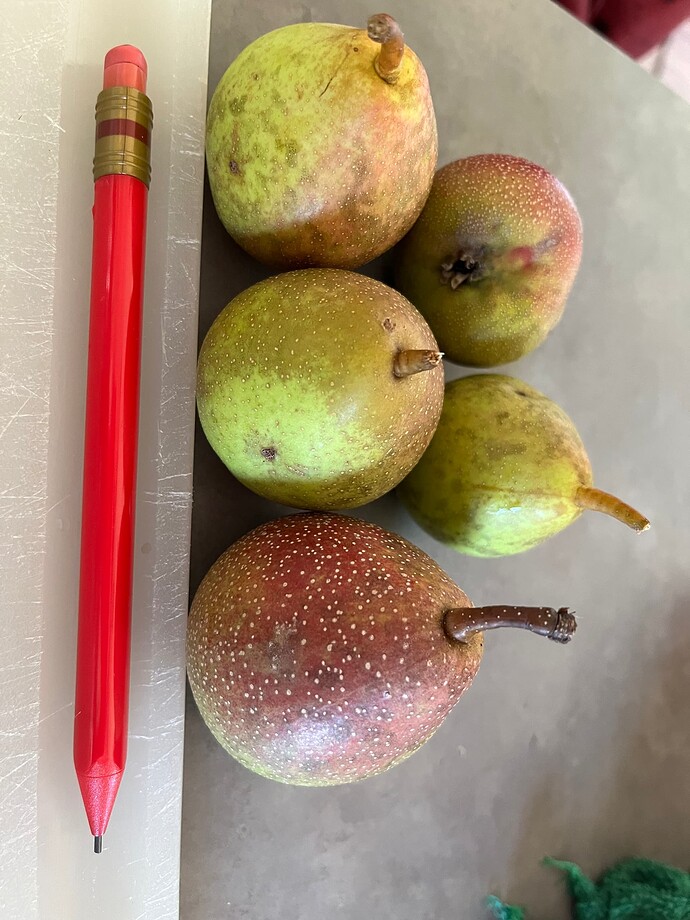Sounds like i better plant that in my no height limit space. Thanks.
Its the year all pears are smaller this year. Winter drug on l9nger than expected. Black leaves can be caused by scab, wind damage etc. The pictures dont really give me a clue. Black leaves can also be fireblight or other doseases.
The size of pears depends on location and variety. In Kansas 30 feet is a big pear. Bradford are taller rootstocks and can be a factor in height. Most callery are not bradford. Trie bradford get fireblight unlike wild callery.
Had my fields bushhogged recently… walked the field edges today looking for persimmon and bradford / callery seedlings…
Found 20 or more persimmon seedlings … well some were 30 ft tall others 4 or 5 ft tall. None had fruit developed even though some were getting pretty good sun and were good sized.
I did find one more nice callery sapling… 5 ft tall… 1/2 inch diameter trunk. I found one other a bit larger earlier just off my back yard.
Hope to get those two transplanted into my field when dormant this winter… so i can graft them.
I had a few others located… but those nice hwy brush clearing guys cut and chipped them up.
They will regrow from the roots.
Anybody know how big asian on callery get? I heard asians do not get as big as euro on callery. I’ve got several euro on callery climbing to 30 foot.
They are slightly shorter on my property around 20-25 feet.
I picked these this afternoon as I was, from inside, watching a doe eating for a while under the tree. She seemed to be getting something from the ground and I was guessing it was dropped fruit. They’re Ayers- so I wait for 5-8 days to let them ripen?? I tried one the week before last; it was super hard and didn’t have much flavor.
Meant to say that I used the “lift test” and they did break off except one where you can see the stem broke in an u usual place.
Yes they will soften up over the next week or so. The color has changed slightly to more yellow. They will get very yellow when ripe. They appear smaller than normal but so are mine this year so far. Ayers are soft and juicy and sweet once ripe. That doe may have given your tree a little shake.
Thanks, Clarke! Yes, they’re all quite small. Ok, so should I go ahead and harvest a bunch and let them ripen inside?
It seems slightly early but if they easily break off in your hand when tilted up slightly yes you should. Leave them on your tree as long as you can they will taste better. As you mentioned its a competition as well to see who gets to the pears first. You want to be ahead of the furry, feathered, and insects that live there.
I’m in northern VA myself. My Ayers will not be done till near the end of august. I’m not a fan of the tilt test. The bees will usually start drilling into them about two weeks before you should pick.
Ah, ok. I do recall some huge bees drilling into the few fruits I had last year, and maybe that was later in August. They were European hornets, I think. They were rather scary to me! I’d love to beat them but maybe they are too early for the fruit to be ready. Thanks!
I picked all of my ayers last week here in AL. A few dropped and the rest came off very easy with even a little bit of tilt. Put them in the fridge for a couple of weeks then I’ll pull them out to ripen on the counter. This is my first year with a decent harvest of this variety. I tried an under-ripe one a few weeks ago and it was hard as a rock but already pretty sweet. Most of them were on the small side.
My #1 failure at growing pears here is Fire Blight… tried several varieties over a string of years and all died of FB around yr 3.
I have not tried improved keiffer on callery… but that will be my next attempt.
Are there any asian pear varieries when combined with callery rootstock that are known to be very reasistent to FB ?
Thanks
Many reports that Korean Giant pear has good blight resistance.
Thanks @hambone … i remember several posting pictures of those pears last fall… they sure looked impressive.
Would be nice if i could get those to live here.
I have found several nice wild callery here on my place… and will get them transplanted this winter while dormant.
Graft next spring ? After transplanting late fall or early winter ?
Or should i give them a season to grow once transplanted… and graft the next spring ?
Thanks
I’m doing the same thing. Will be digging some wild pears to plant and graft next spring. I think its better to let them grow in place a year first, but since all of this is free, I’m not worried about it.
This year I grafted a few recently transplanted Callery and it worked just fine.
I would not hesitate to graft pear on recently transplanted rootstock. Pear is one of the easiest species to graft. The only caution I would take is to ensure I could water them in a dry spell.
